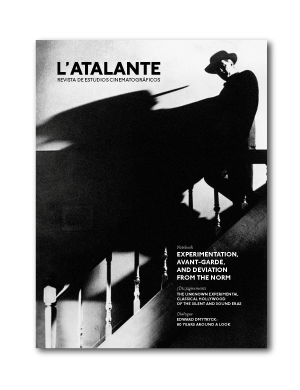Vanishing Points
Slapstick and Monstrosities: a Rhetoric of Excess in Roberto Benigni’s Comic Cinema
Published 2019-01-31
Keywords
- Italian Cinema,
- Roberto Benigni,
- Monstrosity,
- Excess,
- Normality
- Jester,
- Comedy ...More
How to Cite
Bracco, D. (2019). Slapstick and Monstrosities: a Rhetoric of Excess in Roberto Benigni’s Comic Cinema. L’Atalante. Journal of Film Studies, (27), 175–186. https://doi.org/10.63700/645
Abstract
In 1994, Roberto Benigni directed the comedy of errors The Monster (Il Mostro), whose protagonist, the marginalised Loris, becomes the target of an erroneous police investigation as monstrous as the serial killer the authorities suspect him of being throughout the story. Like the director’s four previous feature films, this picture is centred on the burlesque figure of the jester, who embodies a rhetoric of excess that Benigni uses to paint a caustic picture of 1990s Italy and its dysfunctions. This article examines this rhetoric of excess, which is based on a constant questioning of the normality/monstrosity dialectic. The excesses of Benigni’s character position him on the fringes of a society against which he struggles in vain, using the resistance of the burlesque body to oppose the repressive social norms whose guarantors want to confine him in the territory of the monstrous. His literally eccentric position turns him into an excessive figure who is prepared to transgress the foundational pact of the social body. Indeed, Italian society is the main target of Benigni’s satire in a film that combines burlesque mechanisms and carnivalesque strategies to expose the aberrations of the established order and the monstrously manipulative power of its agents.Downloads
Download data is not yet available.
References
Amiel, V. (1998). <em>Le Corps au cinéma: Keaton, Bresson, Cassavetes</em>. París: Presses Universitaires de France.<br>
Bajtín, M. (1965). <em>L’Œuvre de François Rabelais et la culture populaire au Moyen-Âge et sous la Renaissance</em>. París: Gallimard.<br>
Borsatti, C. (2002). <em>Roberto Benigni</em>. Milán: Il Castoro cinema.<br>
Celli, M. (2001). <em>The Divine Comic: the Cinema of Roberto Benigni</em>. Lanham: Scarecrow Press.<br>
Colarizi, S. (2007). <em>Storia politica della Reppublica: partiti, movimenti e istituzioni: 1943-2006</em>. Roma: Laterza.<br>
Consentino, A. (1998). <em>La scena dell’osceno: alle radici della drammaturgia di Roberto Benigni</em>. Roma: Odradek.<br>
Corbin, A. (2005). <em>De la Révolution à la Grande Guerre</em>. París: Seuil (colección <em>Histoire du corps</em>, vol. II).<br>
Dreux, E. (2007). <em>Le Cinéma burlesque ou la subversion par le geste</em>. París: L’Harmattan.<br>
Fiorucci, A. (2012). <em>48 small. Il dottore di Perugia e il mostro di Firenze</em>. [s.l.]: Morlacchi.<br>
Foucault, M. (1999). <em>Cours du 22 janvier 1975</em>. En V. Marchetti y A. Salomoni (eds.), <em>Les Anormaux. Cours au Collège de France, 1974-1975 </em>(pp. 37-54). París: Édition de l’École des Hautes Études/Seuil/Gallimard. <br>
Governi, G. (2017). <em>Totò. Vita, opere e miracoli</em>. [s.l.]: Fazi.<br>
Král, P. (1984). <em>Le Burlesque ou Morale de la tarte à la crème</em>. París: Stock.<br>
Lazar, M. (2008). <em>L’Italie sur le fil du rasoir: changements et continuités de l’Italie contemporaine. </em>París: Perrin.<br>
Masi, S. (1999). <em>Roberto Benigni</em>. Roma: Gremese.<br>
Mileschi, C., Sacchelli, O. (2006). <em>Le Clown amoureux: l’œuvre cinématographique de Roberto Benigni</em>. Lyon: La Fosse aux Ours.<br>
Parigi, S. (1989). <em>Roberto Benigni</em>. Nápoles: Ed. Scientifiche Italiane.<br>
Vigarello, G. (2005). <em>De la Renaissance aux Lumières</em>. París: Seuil (colección <em>Histoire du corps</em>, vol. I).
Bajtín, M. (1965). <em>L’Œuvre de François Rabelais et la culture populaire au Moyen-Âge et sous la Renaissance</em>. París: Gallimard.<br>
Borsatti, C. (2002). <em>Roberto Benigni</em>. Milán: Il Castoro cinema.<br>
Celli, M. (2001). <em>The Divine Comic: the Cinema of Roberto Benigni</em>. Lanham: Scarecrow Press.<br>
Colarizi, S. (2007). <em>Storia politica della Reppublica: partiti, movimenti e istituzioni: 1943-2006</em>. Roma: Laterza.<br>
Consentino, A. (1998). <em>La scena dell’osceno: alle radici della drammaturgia di Roberto Benigni</em>. Roma: Odradek.<br>
Corbin, A. (2005). <em>De la Révolution à la Grande Guerre</em>. París: Seuil (colección <em>Histoire du corps</em>, vol. II).<br>
Dreux, E. (2007). <em>Le Cinéma burlesque ou la subversion par le geste</em>. París: L’Harmattan.<br>
Fiorucci, A. (2012). <em>48 small. Il dottore di Perugia e il mostro di Firenze</em>. [s.l.]: Morlacchi.<br>
Foucault, M. (1999). <em>Cours du 22 janvier 1975</em>. En V. Marchetti y A. Salomoni (eds.), <em>Les Anormaux. Cours au Collège de France, 1974-1975 </em>(pp. 37-54). París: Édition de l’École des Hautes Études/Seuil/Gallimard. <br>
Governi, G. (2017). <em>Totò. Vita, opere e miracoli</em>. [s.l.]: Fazi.<br>
Král, P. (1984). <em>Le Burlesque ou Morale de la tarte à la crème</em>. París: Stock.<br>
Lazar, M. (2008). <em>L’Italie sur le fil du rasoir: changements et continuités de l’Italie contemporaine. </em>París: Perrin.<br>
Masi, S. (1999). <em>Roberto Benigni</em>. Roma: Gremese.<br>
Mileschi, C., Sacchelli, O. (2006). <em>Le Clown amoureux: l’œuvre cinématographique de Roberto Benigni</em>. Lyon: La Fosse aux Ours.<br>
Parigi, S. (1989). <em>Roberto Benigni</em>. Nápoles: Ed. Scientifiche Italiane.<br>
Vigarello, G. (2005). <em>De la Renaissance aux Lumières</em>. París: Seuil (colección <em>Histoire du corps</em>, vol. I).

